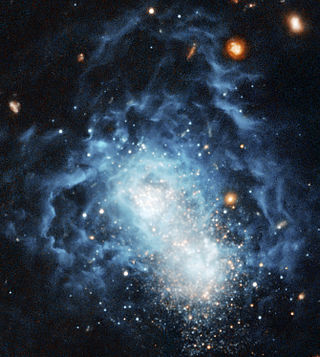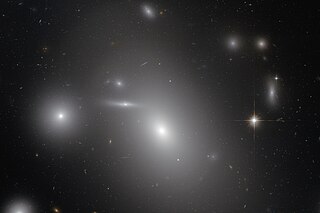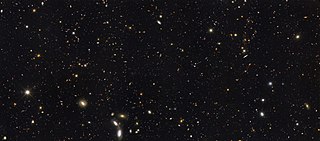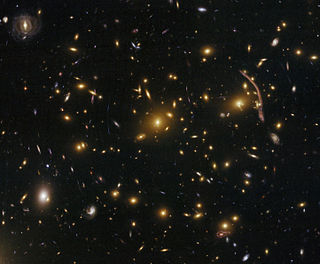Related Research Articles

Fornax is a constellation in the southern celestial hemisphere, partly ringed by the celestial river Eridanus. Its name is Latin for furnace. It was named by French astronomer Nicolas Louis de Lacaille in 1756. Fornax is one of the 88 modern constellations.

A galaxy is a system of stars, stellar remnants, interstellar gas, dust, and dark matter bound together by gravity. The word is derived from the Greek galaxias (γαλαξίας), literally 'milky', a reference to the Milky Way galaxy that contains the Solar System. Galaxies, averaging an estimated 100 million stars, range in size from dwarfs with less than a thousand stars, to the largest galaxies known – supergiants with one hundred trillion stars, each orbiting its galaxy's center of mass. Most of the mass in a typical galaxy is in the form of dark matter, with only a few percent of that mass visible in the form of stars and nebulae. Supermassive black holes are a common feature at the centres of galaxies.

A globular cluster is a spheroidal conglomeration of stars that is bound together by gravity, with a higher concentration of stars towards their centers. They can contain anywhere from tens of thousands to many millions of member stars, all orbiting in a stable, compact formation. Globular clusters are similar in form to dwarf spheroidal galaxies, and the distinction between the two is not always clear. Their name is derived from Latin globulus. Globular clusters are occasionally known simply as "globulars".
The following is a timeline of galaxies, clusters of galaxies, and large-scale structure of the universe.

A galaxy cluster, or a cluster of galaxies, is a structure that consists of anywhere from hundreds to thousands of galaxies that are bound together by gravity, with typical masses ranging from 1014 to 1015 solar masses. They are the second-largest known gravitationally bound structures in the universe after some superclusters (of which only one, the Shapley Supercluster, is known to be bound). They were believed to be the largest known structures in the universe until the 1980s, when superclusters were discovered. One of the key features of clusters is the intracluster medium (ICM). The ICM consists of heated gas between the galaxies and has a peak temperature between 2–15 keV that is dependent on the total mass of the cluster. Galaxy clusters should not be confused with galactic clusters (also known as open clusters), which are star clusters within galaxies, or with globular clusters, which typically orbit galaxies. Small aggregates of galaxies are referred to as galaxy groups rather than clusters of galaxies. The galaxy groups and clusters can themselves cluster together to form superclusters.

The Andromeda Galaxy is a barred spiral galaxy and is the nearest major galaxy to the Milky Way. It was originally named the Andromeda Nebula and is cataloged as Messier 31, M31, and NGC 224. Andromeda has a D25 isophotal diameter of about 46.56 kiloparsecs (152,000 light-years) and is approximately 765 kpc (2.5 million light-years) from Earth. The galaxy's name stems from the area of Earth's sky in which it appears, the constellation of Andromeda, which itself is named after the princess who was the wife of Perseus in Greek mythology.

A starburst galaxy is one undergoing an exceptionally high rate of star formation, as compared to the long-term average rate of star formation in the galaxy, or the star formation rate observed in most other galaxies.

The Hubble Ultra-Deep Field (HUDF) is a deep-field image of a small region of space in the constellation Fornax, containing an estimated 10,000 galaxies. The original data for the image was collected by the Hubble Space Telescope from September 2003 to January 2004 and the first version of the image was released on March 9, 2004. It includes light from galaxies that existed about 13 billion years ago, some 400 to 800 million years after the Big Bang.

Allan Rex Sandage was an American astronomer. He was Staff Member Emeritus with the Carnegie Observatories in Pasadena, California. He determined the first reasonably accurate values for the Hubble constant and the age of the universe.

I Zwicky 18 is a blue compact dwarf galaxy located about 59 million light years away in the constellation Ursa Major. The galaxy was first identified by Swiss astronomer Fritz Zwicky in a 1930s photographic survey of galaxies.

Interacting galaxies are galaxies whose gravitational fields result in a disturbance of one another. An example of a minor interaction is a satellite galaxy disturbing the primary galaxy's spiral arms. An example of a major interaction is a galactic collision, which may lead to a galaxy merger.

Abell 1689 is a galaxy cluster in the constellation Virgo over 2.3 billion light-years away.

The Andromeda–Milky Way collision is a galactic collision predicted to occur in about 4.5 billion years between the two largest galaxies in the Local Group—the Milky Way and the Andromeda Galaxy. The stars involved are sufficiently far apart that it is improbable that any of them will individually collide, though some stars will be ejected.

NGC 4889 is an E4 supergiant elliptical galaxy. It was discovered in 1785 by the British astronomer Frederick William Herschel I, who catalogued it as a bright, nebulous patch. The brightest galaxy within the northern Coma Cluster, it is located at a median distance of 94 million parsecs from Earth. At the core of the galaxy is a supermassive black hole that heats the intracluster medium through the action of friction from infalling gases and dust. The gamma ray bursts from the galaxy extend out to several million light years of the cluster.

The Great Observatories Origins Deep Survey, or GOODS, is an astronomical survey combining deep observations from three of NASA's Great Observatories: the Hubble Space Telescope, the Spitzer Space Telescope, and the Chandra X-ray Observatory, along with data from other space-based telescopes, such as XMM Newton, and some of the world's most powerful ground-based telescopes.

Abell 370 is a galaxy cluster located nearly 5 billion light-years away from the Earth, in the constellation Cetus. Its core is made up of several hundred galaxies. It was catalogued by George Abell, and is the most distant of the clusters he catalogued.

M60-UCD1 is an ultracompact dwarf galaxy. It is 49 million light years from Earth, close to Messier 60 in the Virgo Cluster. Half of its stellar mass is in the central sphere 160 light years in diameter.

IDCS J1426.5+3508 is an extremely massive young galaxy cluster. It is the most massive galaxy cluster detected at such an early age.

GN-z11 is a high-redshift galaxy found in the constellation Ursa Major. It is among the farthest known galaxies from Earth ever discovered. The 2015 discovery was published in a 2016 paper headed by Pascal Oesch and Gabriel Brammer. Up until the discovery of JADES-GS-z13-0 in 2022 by the James Webb Space Telescope, GN-z11 was the oldest and most distant known galaxy yet identified in the observable universe, having a spectroscopic redshift of z = 10.957, which corresponds to a proper distance of approximately 32 billion light-years. Data published in 2024 established that the galaxy contains the most distant, and therefore earliest, black hole known in the universe, estimated at around 1.6 million solar masses.

Bedin I is a dwarf spheroidal galaxy located in the constellation Pavo. It is situated around 28.38 million light-years from Earth, behind the globular cluster NGC 6752. Bedin I is possibly one of the oldest galaxies known, having formed around 10–13 billion years ago, and is one of the most isolated dwarf galaxies known, situated around 2.12 million light-years away from NGC 6744, its nearest neighbor with which it may be physically associated. As such, it has been deemed by astronomers as a "fossil" from the early universe. It was accidentally discovered by Italian astronomer Luigi Bedin, whose team was studying white dwarfs in NGC 6752 using the Hubble Space Telescope in September 2018; the discovery was announced in a paper published in January 2019.
References
- 1 2 3 "[SWM2014] GOODS-N 774". SIMBAD . Centre de données astronomiques de Strasbourg . Retrieved 2021-01-26.
- ↑ "hs-2014-37-c". GOODS-North. Hubblesite. Archived from the original on 2016-03-03. Retrieved 2014-08-14.
- 1 2 "Witnessing the early growth of a giant". SpaceDaily. 29 August 2014.
- 1 2 "Early growth of giant galaxy, just 3 billion years after the Big Bang, revealed". ScienceDaily. 27 August 2014.
- ↑ Elahe Izadi (29 August 2014). "Astronomers spot the birth of 'Sparky,' a massive star factory". Washington Post .
- ↑ "Astronomers Discover a Massive Galaxy in Its Core Formation Phase". SciTechDaily. 28 August 2014.
- ↑ Pete Spotts (29 August 2014). "'Sparky' and its new stars give clues to how massive galaxies evolve". Christian Science Monitor.